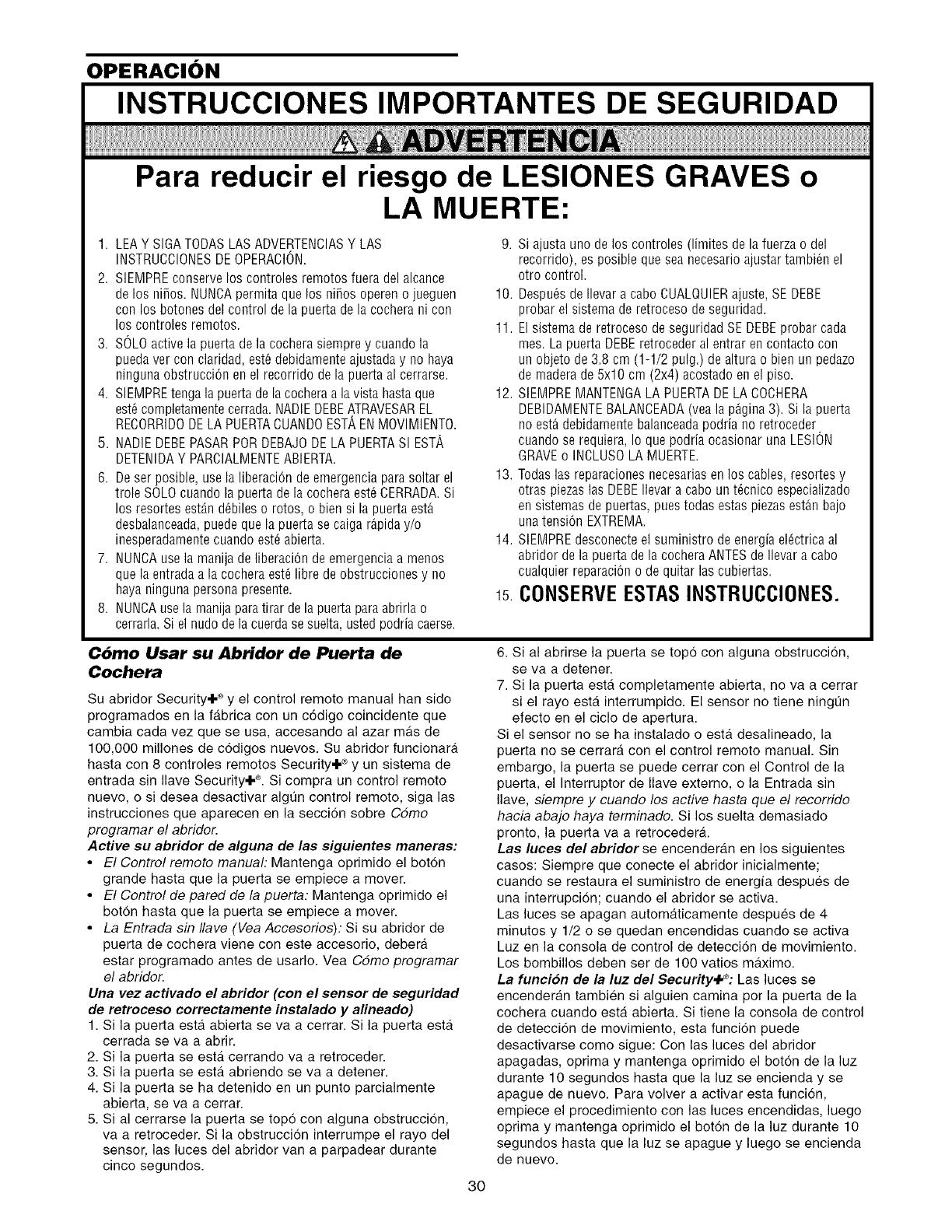
OPERACION
INSTRUCCIONES IMPORTANTES DE SEGURIDAD
Para reducir el riesgo de LESIONES GRAVES o
LA MUERTE:
1. LEAY SIGATODASLASADVERTENCIASY LAS
INSTRUCCIONESDEOPERACION.
2. SIEMPREconserve los controles remotos fuera del alcance
de los ni_os. NUNCApermita quelos ni_os operen o jueguen
con los botones del control de la puerta de la cocherani con
los controles remotos.
3. SOLOactive la puertade la cocherasiempre y cuando la
pueda ver con claridad, est_debidamente ajustada y no haya
ninguna obstrucci6n en el recorrido de lapuerta al cerrarse.
4. SIEMPREtengala puerta de lacocheraa lavista hastaque
est6 completamentecerrada. NADIEDEBEATRAVESAREL
RECORRIDODELA PUERTACUANDOESTAENMOVIMIENTO.
5. NADIEDEBEPASARPOR DEBAJODELA PUERTASI ESTA
DETENIDAY PARCIALMENTEABIERTA.
6. Deset posible, use la liberaci6n de emergencia parasoltar el
trole SOLOcuando la puerta de la cochera est6 CERRADA.Si
los resortes est_.nd6biles o rotos, o bien si la puerta est_
desbalanceada,puede quela puerta se caiga r_piday/o
inesperadamentecuando est_ abierta.
7. NUNCAuse la manijade liberaci6n de emergencia amenos
que la entrada ala cochera est_ libre de obstrucciones y no
hayaninguna persona presente.
8. NUNCAusela manijaparatirar de la puerta paraabrirla o
cerrarla.Si el nudo de lacuerda sesuelta,usted podria caerse.
9. Si ajusta uno de los controles (limites de la fuerza o del
recorrido), esposible que sea necesarioajustar tambi_n el
otro control.
10. Despu6sde Ilevaracabo CUALQUIERajuste, SEDEBE
probar el sistema de retroceso de seguridad.
11. El sistema de retroceso deseguridad SEDEBEprobar cada
mes. La puerta DEBEretroceder al entrar en contacto con
un objeto de 3.8 cm (1-1/2 pulg.) de altura o bien un pedazo
de maderade 5x10 cm (2x4) acostado en el piso.
12. SIEMPREMANTENGALA PUERTADE LACOCHERA
DEBIDAMENTEBALANCEADA(veala p_gina 3). Si la puerta
no est_ debidamente balanceadapodria no retroceder
cuaodo se requiera,Io que podria ocasionar una LESION
GRAVEo INCLUSOLAMUERTE.
13. Todas las reparaciones necesariasen los cables, resortes y
otras piezas las DEBEIlevar acabo un t_cnico especializado
en sistemas de puertas, puestodas estas piezas est_nbajo
unatensi6n EXTREMA.
14. SIEMPREdesconecte el suministro de energiael_ctrica al
abridor de la puerta de la cochera ANTESde Ilevara cabo
cualquier reparaci6n o de quitar las cubiertas.
15.CONSERVEESTASINSTRUCCIONES.
C6mo Usar su Abridor de Puerta de
Cochera
Su abridor Security÷ ®y el control remoto manual hart sido
programados en la fabrica con un c6digo coincidente que
cambia cada vez que se usa, accesando al azar ma.s de
100,000 millones de c6digos nuevos. Su abridor funcionara
hasta con 8 controles remotos Security÷ ®y un sistema de
entrada sin Ilave Security÷ ®. Si compra un control remoto
nuevo, o si desea desactivar algt]n control remoto, siga las
instrucciones que aparecen en la secci6n sobre Cdmo
programar el abridor.
Active su abridor de alguna de/as siguientes maneras:
• El Control remoto manual: Mantenga oprimido el bot6n
grande hasta que la puerta se empiece a mover.
• El Control de pared de la puerta: Mantenga oprimido el
boton hasta que la puerta se empiece a mover.
• La Entrada sin Ilave (Vea Accesorios): Si su abridor de
puerta de cochera viene con este accesorio, debera
estar programado antes de usarlo. Vea Cdmo programar
el abridor.
Una vez activado el abridor (con el sensor de seguridad
de retroceso correctamente instalado y alineado)
1. Si la puerta esta abierta se va a cerrar. Si la puerta esta
cerrada se va a abrir.
2. Si la puerta se esta cerrando va a retroceder.
3. Si la puerta se esta abriendo se va a detener.
4. Si la puerta se ha detenido en un punto parcialmente
abierta, se va a cerrar.
5. Sial cerrarse la puerta se top6 con alguna obstruccion,
va a retroceder. Si la obstruccion interrumpe el rayo del
sensor, las luces del abridor van a parpadear durante
cinco segundos.
3O
6. Sial abrirse la puerta se top6 con alguna obstruccion,
se va a detener.
7. Si la puerta esta completamente abierta, no va a cerrar
si el rayo esta interrumpido. El sensor no tiene ningt]n
efecto en el ciclo de apertura.
Si el sensor no se ha instalado o esta desalineado, la
puerta no se cerrara con el control remoto manual. Sin
embargo, la puerta se puede cerrar con el Control de la
puerta, el Interruptor de Ilave externo, o la Entrada sin
Ilave, siempre y cuando los active hasta que el recorrido
hacia abajo haya terminado. Si los suelta demasiado
pronto, la puerta va a retroceder&
Las luces tel abridor se encenderan en los siguientes
casos: Siempre que conecte el abridor inicialmente;
cuando se restaura el suministro de energfa despues de
una interrupcion; cuando el abridor se activa.
Las luces se apagan automaticamente despues de 4
minutos y 1/2 o se quedan encendidas cuando se activa
Luz en la consola de control de deteccion de movimiento.
Los bombillos deben ser de 100 vatios maximo.
La funcion de la luz del $ecurity4._: Las luces se
encenderan tambien si alguien camina por la puerta de la
cochera cuando esta abierta. Si tiene la consola de control
de detecci6n de movimiento, esta funci6n puede
desactivarse como sigue: Con las luces del abridor
apagadas, oprima y mantenga oprimido el boton de la luz
durante 10 segundos hasta que la luz se encienda y se
apague de nuevo. Para volver a activar esta funci6n,
empiece el procedimiento con las luces encendidas, luego
oprima y mantenga oprimido el bot6n de la luz durante 10
segundos hasta que la luz se apague y luego se encienda
de nuevo.











































































